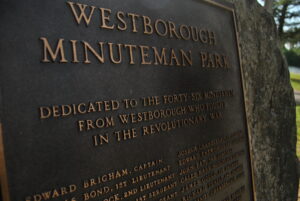Missing Militia Companies from Westborough
In 1975, during the Bicentennial, the town of Westborough dedicated a swath of land next to its reservoir, Sandra Pond, as Minuteman Park.
The town installed a bronze marker listing the names of all the members of its minute company from 1775. Those names appear to have come from the first part of The History of Westborough, Massachusetts, written by the Rev. Heman Packard DeForest and published in 1891.
More recently, Westborough resident David A. Nourse noticed some problems with that marker.
There were small errors, such as naming the captain of the minuteman company as Edward Brigham instead of (as the name appears in the local history, the original muster roll, and other documents) Edmund Brigham. Nourse spotted several other names changed to more common present-day spellings, one man with the wrong rank, and what looks like a last-minute substitute left off entirely.
But the bigger problem, Nourse felt, was that the marker commemorated only one company of local men who responded to the Lexington Alarm. Westborough had three militia companies, and all three submitted rolls to the Massachusetts government listing men who had marched on 19 April. In all there were 101 militiamen, and the plaque named only 46.
In April 2021, Nourse submitted a proposal to the Westborough select board proposing an additional plaque listing all 101 men, making sure the names appeared as they did in the muster rolls.
Nourse’s proposal on “Westborough’s Two Forgotten Revolutionary War Militia Companies” came with an impressive amount of historical documentation, including images of the three muster rolls from the state archives submitted by Brigham, Capt. Seth Morse, and Capt. Joseph Baker.
Nourse also found that DeForest’s book hadn’t transcribed any of those muster rolls but rather Brigham’s November 1775 record of distributing pay for five to seven days of training in the preceding winter. This sheet of paper includes every man’s signature as he received his pay—a striking historical record but not exactly the same thing as an April 1775 muster roll.
The select board referred the question of a new monument to the town’s Trustees of Soldiers’ Memorials. Before making any rash expenditures, they sought to have Nourse’s research vetted. That’s when a new corps entered the action: bloggers.
Anthony Vaver is both Westborough’s Local History Librarian and the creator of the Early American Crime site. On behalf of the town, he contacted me and Alexander Cain, who shares his Revolutionary research at Historical Nerdery. Vaver told me:
TOMORROW: The invention of the minutemen.
The town installed a bronze marker listing the names of all the members of its minute company from 1775. Those names appear to have come from the first part of The History of Westborough, Massachusetts, written by the Rev. Heman Packard DeForest and published in 1891.
More recently, Westborough resident David A. Nourse noticed some problems with that marker.
There were small errors, such as naming the captain of the minuteman company as Edward Brigham instead of (as the name appears in the local history, the original muster roll, and other documents) Edmund Brigham. Nourse spotted several other names changed to more common present-day spellings, one man with the wrong rank, and what looks like a last-minute substitute left off entirely.
But the bigger problem, Nourse felt, was that the marker commemorated only one company of local men who responded to the Lexington Alarm. Westborough had three militia companies, and all three submitted rolls to the Massachusetts government listing men who had marched on 19 April. In all there were 101 militiamen, and the plaque named only 46.
In April 2021, Nourse submitted a proposal to the Westborough select board proposing an additional plaque listing all 101 men, making sure the names appeared as they did in the muster rolls.
Nourse’s proposal on “Westborough’s Two Forgotten Revolutionary War Militia Companies” came with an impressive amount of historical documentation, including images of the three muster rolls from the state archives submitted by Brigham, Capt. Seth Morse, and Capt. Joseph Baker.
Nourse also found that DeForest’s book hadn’t transcribed any of those muster rolls but rather Brigham’s November 1775 record of distributing pay for five to seven days of training in the preceding winter. This sheet of paper includes every man’s signature as he received his pay—a striking historical record but not exactly the same thing as an April 1775 muster roll.
The select board referred the question of a new monument to the town’s Trustees of Soldiers’ Memorials. Before making any rash expenditures, they sought to have Nourse’s research vetted. That’s when a new corps entered the action: bloggers.
Anthony Vaver is both Westborough’s Local History Librarian and the creator of the Early American Crime site. On behalf of the town, he contacted me and Alexander Cain, who shares his Revolutionary research at Historical Nerdery. Vaver told me:
the Trustees are particularly interested in learning the difference between a “Minuteman” vs. a “Militiaman,” if indeed there is one. The park where the memorial sits is called Minuteman Park, and the memorial, of course, is meant to honor that name. We want to make sure that the definitions we are using are commonly, if not universally, accepted.It turned out that Westborough had debated that very question in 1774 and 1775.
TOMORROW: The invention of the minutemen.


No comments:
Post a Comment